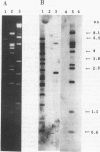Abstract
Salmonella enteritidis is now the most common serotype of the genus Salmonella reported in the United States. Bacteriophage typing has been helpful for subdividing S. enteritidis strains from different sources in the United States. Most S. enteritidis outbreaks reported were egg related, and the majority of them were caused by strains of phage type 8. To determine whether restriction fragment length polymorphism of the rRNA genes (ribotyping) and of the genomic DNAs from two lysogenic phages from S. enteritidis could be used to discriminate between S. enteritidis phage type 8 strains, we conducted Southern hybridization studies on 24 isolates from different outbreaks and six non-outbreak-associated strains using DNA probes for 16S and 23S rRNA genes and S. enteritidis typing phages 1 and 2 from the Ward typing system (L. R. Ward, J. D. H. de Sa, and B. Rowe, Epidemiol. Infect. 99:291-294, 1987). Of seven restriction endonucleases screened with the probe for rRNA genes, AccI provided the best discrimination between strains; six distinct patterns were observed. AccI ribosomal DNA patterns 1 to 6 were detected among 76.7, 3.3, 6.7, 3.3, 3.3, and 6.7% of isolates tested, respectively. Strains of AccI ribosomal DNA pattern 3 could be further subdivided into two additional patterns by using SmaI. Epidemiologically related strains had identical patterns. No discrimination between strains was achieved by probes for phages 1 and 2. No sequences homologous to the phage I probe were detected among phage type 8 strains, and all strains tested with six restriction enzymes had the same hybridization pattern with the phage 2 probe. These findings demonstrate that ribotyping with AccI and SmaI provides an additional means of discriminating between some phage type 8 strains; however, ribotyping and the phage 2 hybridization results from egg-related outbreak strains support previous findings that these strains are closely related.
Full text
PDF




Images in this article
Selected References
These references are in PubMed. This may not be the complete list of references from this article.
- Almeida R. J., Cameron D. N., Cook W. L., Wachsmuth I. K. Vibriophage VcA-3 as an epidemic strain marker for the U.S. Gulf Coast Vibrio cholerae O1 clone. J Clin Microbiol. 1992 Feb;30(2):300–304. doi: 10.1128/jcm.30.2.300-304.1992. [DOI] [PMC free article] [PubMed] [Google Scholar]
- Altwegg M., Hickman-Brenner F. W., Farmer J. J., 3rd Ribosomal RNA gene restriction patterns provide increased sensitivity for typing Salmonella typhi strains. J Infect Dis. 1989 Jul;160(1):145–149. doi: 10.1093/infdis/160.1.145. [DOI] [PubMed] [Google Scholar]
- Esteban E., Snipes K., Hird D., Kasten R., Kinde H. Use of ribotyping for characterization of Salmonella serotypes. J Clin Microbiol. 1993 Feb;31(2):233–237. doi: 10.1128/jcm.31.2.233-237.1993. [DOI] [PMC free article] [PubMed] [Google Scholar]
- Hickman-Brenner F. W., Stubbs A. D., Farmer J. J., 3rd Phage typing of Salmonella enteritidis in the United States. J Clin Microbiol. 1991 Dec;29(12):2817–2823. doi: 10.1128/jcm.29.12.2817-2823.1991. [DOI] [PMC free article] [PubMed] [Google Scholar]
- Martinetti G., Altwegg M. rRNA gene restriction patterns and plasmid analysis as a tool for typing Salmonella enteritidis. Res Microbiol. 1990 Nov-Dec;141(9):1151–1162. doi: 10.1016/0923-2508(90)90088-8. [DOI] [PubMed] [Google Scholar]
- Pignato S., Giammanco G., Grimont F., Grimont P. A. Molecular typing of Salmonella enterica subsp. enterica serovar Wien by rRNA gene restriction patterns. Res Microbiol. 1992 Sep;143(7):703–709. doi: 10.1016/0923-2508(92)90065-v. [DOI] [PubMed] [Google Scholar]
- Salvi R. J., Ahroon W., Saunders S. S., Arnold S. A. Evoked potentials: computer-automated threshold-tracking procedure using an objective detection criterion. Ear Hear. 1987 Jun;8(3):151–156. [PubMed] [Google Scholar]
- Southern E. M. Detection of specific sequences among DNA fragments separated by gel electrophoresis. J Mol Biol. 1975 Nov 5;98(3):503–517. doi: 10.1016/s0022-2836(75)80083-0. [DOI] [PubMed] [Google Scholar]
- Ward L. R., de Sa J. D., Rowe B. A phage-typing scheme for Salmonella enteritidis. Epidemiol Infect. 1987 Oct;99(2):291–294. doi: 10.1017/s0950268800067765. [DOI] [PMC free article] [PubMed] [Google Scholar]




